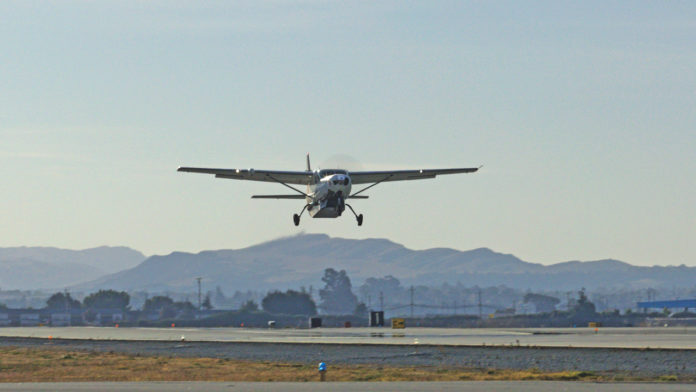As Robert W. Rose was flying in for a landing a few years ago at San Martin airport, he remembers how distracted he was. It was his first lesson and, as his flight instructor was attempting to coach him through the complicated landing process, Rose was only thinking one thing: “Why isn’t this automated?”
The instructor helped Rose land the plane safely, but the question lingered in his mind. Now, Rose’s company, Mountain View-based Reliable Robotics, is at the forefront of pilotless flight technology. This past November, the company conducted a successful 12 minute test of a Cessna 208B Caravan out of Hollister Municipal Airport—with no pilot in the cockpit.
“[This is] very significant for us and I think significant for aviation overall,” said Rose, who is the company’s co-founder and CEO.
Reliable Robotics first tested remote piloting in 2019, with the flight of a four-passenger Cessna 172, which was also tested in Hollister. The latest test was more ambitious, scaling up to a larger cargo plane for the November run.
“This latest flight was significant for us because the Cessna Caravan is substantially larger in the passenger configuration. This is a 12-passenger aircraft. In the cargo configuration, it carries about 3,000 pounds,” Rose says.
On Nov. 21 of this year, the plane performed an automated takeoff and landing, but while in the air it was remotely controlled by pilot Danah Tommalieh from the company’s headquarters located 50 miles away. The system does not employ any manual controls to actively fly the plane, but instead gives the remote pilot a menu of “valid, safe options,” Rose said in a recent interview with Forbes. The commands chosen by the remote pilot are evaluated to make sure the aircraft is not flying too close to the ground or at a dangerous speed.
Currently, Reliable Robotics is collaborating with the U.S. Air Force as it develops its pilotless technology. However, the company is also exploring commercial uses for the automated aircraft. Rose said they are exploring a partnership with FedEx Corporation’s cargo transportation division. Rose hopes to adapt pilotless technology to make air cargo transportation safer.
“There’s a misconception that aviation is the safest mode of transportation. The aviation industry likes to repeat this over again. And that’s true for large passenger aircraft. [But] there are some academic studies that have looked at this more recently that have found smaller planes are actually eight to 15 times more dangerous than driving,” Rose said.
Human error factors such as fatigue or disorientation contribute to airplane crashes and although commercial airliners do employ more automated controls to increase safety, it is not the norm for smaller crafts.
“You don’t need to look very far to find examples of accidents where people in very stressful situations made the wrong decision that ultimately resulted in their death,” Rose said.
Rose brings 20 years of experience working with automation technology to the table, having previously been the director of flight software at SpaceX. Notably, he was part of the team that developed the first fully unassisted self driving vehicle while working at Tesla. Now, he is tapping into his passion for flying to revolutionize automated flight.
Reliable Robotics has been working with the Federal Aviation Administration (FAA) for years in order to get its pilotless technology up to federal standards. Rose expects to do a lot more testing and simulation as they work their way to a widely-usable technology. As AI and automation begin to take hold in various industries, Rose acknowledges that there is apprehension regarding its use.
During the Cessna’s tests at Hollister Municipal Airport, Rose said that the pilotless airplane drew some curious commentary from other (human) pilots.
“We’ve had some fun occurrences where people have shown up and said on the radio ‘hey, am I talking to a robot? Am I talking to an AI?” Rose explains.
While other pilots might be initially wary that they might be communicating with an airborne version of Chat GPT, they will be speaking with a human pilot—even if that person is located in Mountain View.
Despite the skepticism, Rose believes that for certain fields, such as air transportation, the safety benefits are worth exploring.
“I understand where people are coming from when they are confronted with this technology. But I also see the other side of it—I see the safety benefits of automation. Any good pilot will admit to you that they’ve been in situations before that they should not have been in where another level of automation would have gone a long way to improve safety.”








